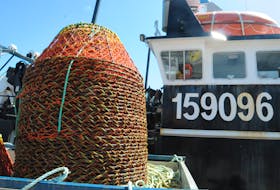“If we grow successfully here, then the dairy farmers can feed (it) to the animals and then that way they can get more milk,” said Mumtaz Cheema, and agronomist at Grenfell Campus, Memorial University of Newfoundland in Corner Brook.
Friday, Cheema and four students working on the project visited the corn plots they are growing at the Forestry and Agrifoods Agency’s Western Agriculture Center and Research Station in Pynn’s Brook.
The project, in its second year, involves the study of five silage varieties of corn, a crop that provides high energy for dairy cows.
“The objective is to find a good variety that can be successfully grown here,” said Cheema, standing in front of row after row of tall corn stalks.
The research is also to determine which varieties have the capability to get more nutrients from the soil.
Last year’s harvest was also analyzed to see which variety had more qualitative traits — “More protein, more fat, more starch, more fibre,” said Cheema.
Cheema said based on data so far they have identified two varieties: Yukon and DKC2628, as the top performers.
But, he said, there are so many other external factors that can influence the growth, yield and biomass that he is interested in carrying on the project for a third year and has applied for funding to do so.
Cheema said they want to find out which varieties are more resilient to low heating units — the temperature crops need to grow. He’s also interested in the impact of growing corn on the emission of greenhouse gases.
Just a few plots away is another research project that is being done in collaboration with Cheema’s work.
Raymond Thomas, associate professor in boreal ecosystems and agriculture sciences, is the lead on project looking at improved soil health, forage yield and forage quality by intercrossing vine soybeans and forage corn.
Where corn is an exhaustive crop, soybeans are restorative and can add protein to the soil and forage quality of the corn. It can also increase soil quality by fixing atmospheric nitrogen.
In the first year of the project, Thomas and masters of science student Muhammad Zaeem have planted the two best varieties identified by Cheema with several novel varieties of soybean intermixed.
“We have the same end goal in that we want to see what the forage quality is at the end of the day,” said Thomas.
Twitter: @WS_DianeCrocker
“If we grow successfully here, then the dairy farmers can feed (it) to the animals and then that way they can get more milk,” said Mumtaz Cheema, and agronomist at Grenfell Campus, Memorial University of Newfoundland in Corner Brook.
Friday, Cheema and four students working on the project visited the corn plots they are growing at the Forestry and Agrifoods Agency’s Western Agriculture Center and Research Station in Pynn’s Brook.
The project, in its second year, involves the study of five silage varieties of corn, a crop that provides high energy for dairy cows.
“The objective is to find a good variety that can be successfully grown here,” said Cheema, standing in front of row after row of tall corn stalks.
The research is also to determine which varieties have the capability to get more nutrients from the soil.
Last year’s harvest was also analyzed to see which variety had more qualitative traits — “More protein, more fat, more starch, more fibre,” said Cheema.
Cheema said based on data so far they have identified two varieties: Yukon and DKC2628, as the top performers.
But, he said, there are so many other external factors that can influence the growth, yield and biomass that he is interested in carrying on the project for a third year and has applied for funding to do so.
Cheema said they want to find out which varieties are more resilient to low heating units — the temperature crops need to grow. He’s also interested in the impact of growing corn on the emission of greenhouse gases.
Just a few plots away is another research project that is being done in collaboration with Cheema’s work.
Raymond Thomas, associate professor in boreal ecosystems and agriculture sciences, is the lead on project looking at improved soil health, forage yield and forage quality by intercrossing vine soybeans and forage corn.
Where corn is an exhaustive crop, soybeans are restorative and can add protein to the soil and forage quality of the corn. It can also increase soil quality by fixing atmospheric nitrogen.
In the first year of the project, Thomas and masters of science student Muhammad Zaeem have planted the two best varieties identified by Cheema with several novel varieties of soybean intermixed.
“We have the same end goal in that we want to see what the forage quality is at the end of the day,” said Thomas.
Twitter: @WS_DianeCrocker








